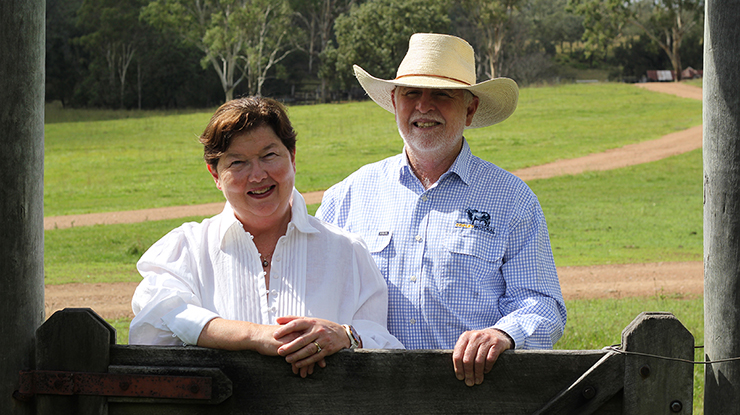 Marie and Tom Copley, beef producers from Anduramba, Queensland.
Marie and Tom Copley, beef producers from Anduramba, Queensland.
Faced with a challenging climate and the myriad of variables involved in breeding cattle, Queensland seedstock producers Tom and Marie Copley are leveraging genetics to map out a productive path for their herd.
Certain in the knowledge that their genetic inputs are entirely within their control, the couple has made gains with a data-driven focus on fertility at their property, 'Salty'. The result is a robust, well-adapted herd, capable of thriving in harsh conditions with minimal inputs.
Here's a look at how the Copleys' astute use of functional analysed genetics and dedication to the long game have been key to achieving their breeding objectives.
Prioritising fertility
Fertility is the cornerstone of their breeding strategy.
"We have a fertility focus to create an efficient and productive cow herd," Marie said.
"We have a tight joining with all heifers joined and required to calve every year. Unproductive females are culled, no exceptions.
"The breeding herd will eat more than 70% of the annual grass budget, so we need a herd that's productive and fertile with minimal inputs."
Despite fertility requiring more time and effort to influence compared to a trait such as growth, which can be altered within a couple of generations, Tom and Marie have persisted with a fertility-first strategy and a balanced approach to growth.
The result is a low maintenance, tropically adapted and highly fertile herd. Their cattle don't require fly or tick management, a strategy which has reduced input costs.
"You need a consistent and measured long-term view as the gains are incremental," Tom said.
"In northern Australia, where the environment is harsher, the more important the fertility traits are.
"We're looking for data that demonstrates cow families with evidence of maternal success meaning numbers of generations of calves."
Making the most of their data
As early adopters of BREEDPLAN, the Copleys have fine-tuned their selection decisions over time.
The couple put their entire herd onto BREEDPLAN and conducted extensive genomic testing.
They use HerdMASTER to transfer their data through to BREEDPLAN with genomic data and then review the herd's estimated breeding values (EBVs), plot the genetic gain across various traits, maintain quality assurance and review maternal performance.
EBV targets:
- Days to Calving – bulls with lower Days to Calving will produce daughters that conceive earlier in the joining period
- Scrotal Size – this is correlated with early puberty in bulls and thus in their sisters and daughters
- Moderate, Early Growth – for low maintenance, fertile females.
A perfect match
It was important for the Copleys to work with a seedstock producer who also uses BREEDPLAN, has a fertility focus, and operates under a similar management criterion.
"We're not after pampered cattle. With the seedstock bulls, we're looking for a lot of analysis, rather than bulls fed lots of grain so they look good," Tom said.
They attribute much of their success to finding a seedstock producer who analysed their herd, was able to influence and understand their system, and had the data to demonstrate they were making progress.
"Selecting your seedstock producer is almost more important than selecting your bulls," Marie said.
"Once you have the right seedstock producer, they will have the range of genetics available to you to meet your breeding objectives."
Long-term gains
This data-driven approach has certainly paid off. The Copleys contributed cattle to the MLA and University of Queensland Northern Genomics Project – analysis of their heifers showed strong fertility, well above industry average. More than 60% of the Copleys' group of heifers which were genotyped were in the top 40% for puberty and body condition score while being moderately framed.
The first group of bulls the Copleys measured in 1986 had an EBV of -1.5 for Days to Calving – which is close to the current breed average (-1.9). The Copleys have seen this plummet to -19.1 for their 2022 bull team – a testament to their breeding strategy.
Record keeping
These impressive results would not have been possible without Tom and Marie's dedication to extensive data collection and documentation.
"If you don't have data, it's just an opinion," Tom said.
"Good management and good record keeping go hand-in-hand."






